|
|
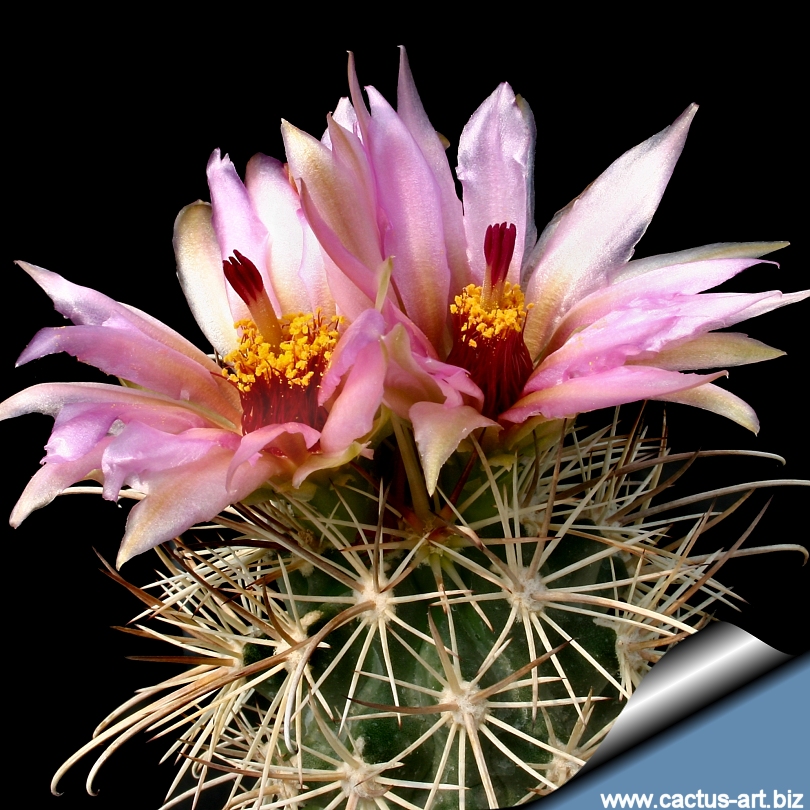
RP108 from Green River, Emery County, Utah, USA
Strong grower, very attractive with great
colourful spines.
|
Description:
This is the most frequent and well known cactus of the cold American
deserts. Due to its vast region of origin the plants vary in the amount
and colouring of hooked central spines as well as in flower colour. The
plant dimensions vary from minuscule plants of only a few cm living
almost buried in the ground, to
the largest plants up to 45cm and 15 cm in
diameter. The
scientific classification of this plant has been controversial.
Many names, forms, subspecies or varieties have been proposed and changed.
Stems: usually unbranched, but also branched near
the base,
depressed-spheric, spheric, cylindrical, or elongated-cylindric, with
tubercles evident on ribs.
Spines: often obscuring stems; radial spines 8-17 per areole, usually
white, sometimes brown or purplish pink, 6-36 mm; central spines 4-8
per areole, 1-5 hooked usually purple- black, hooked, 15-72 mm;
lateral spines 2-6 per areole, similar to centrals, usually shorter
and not not hooked usually white (rarely gray, straw colored, pink,
or reddish brown), flat to angled straight (rarely contorted.
Flowers:
The crown of campanulate flowers in late spring are spectacular,
usually rose to purple, pink, but also multicolour, yellow or (rarely)
white.
Fruits: green turning reddish pink with a few scales.
|
|
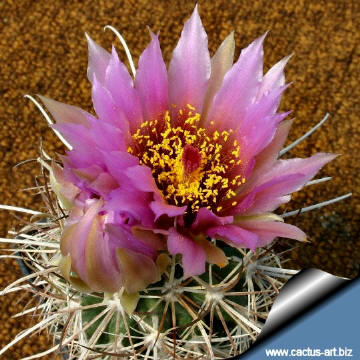
Flower |
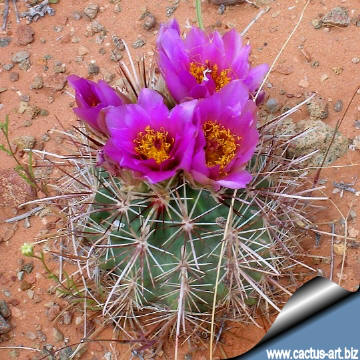
A plant in Habitat (photo by
Wilfried Stolz) |
Cultivation: Rarely seen in
cultivation, it needs perfect drainage to flourish. It is quite
difficult to grow on its own roots and to propagate (only 2-3 percent of
seeds germinate ). Mature individuals easily rot and die.
It is indispensable to provide a greenhouse with good ventilation and
full sun exposure. Keep totally dry during winter. It can tolerate
temperature below zero (-20° C). Plants grafted on hardy Opuntia
compressa stock are quite easy to grow, and no special skill is
required.
Propagation:
Seeds are extremely difficult to
germinate (only 2-3 percent of seeds
germinate). Grafting is often used to speed growth rate and to
create a back-up for plants in collection.
|
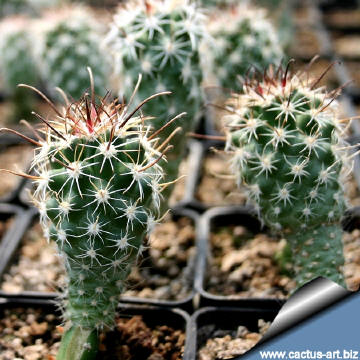 |
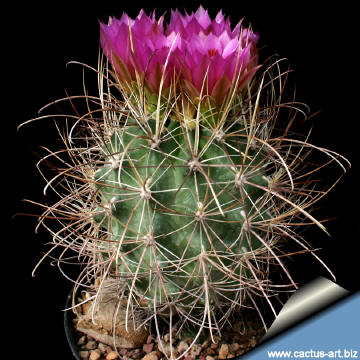 |
|
A young plant grafted on
Opuntia compressa...
and an adult one. |
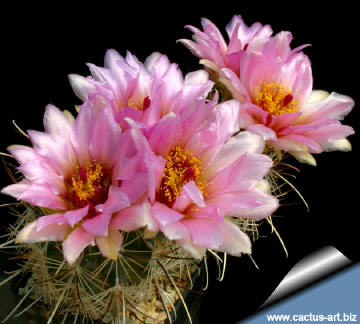
|
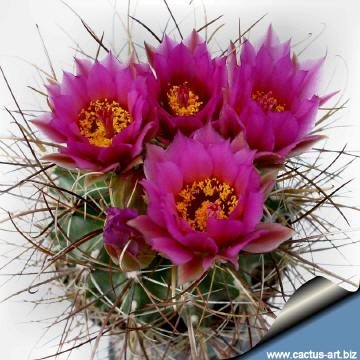 |
|
Photo of conspecific taxa, varieties, forms and
cultivars of Sclerocactus parviflorus .

 |
|
Advertising
|
|
|
|
|
|
|
Family:
Cactaceae (Cactus
Family) |
Scientific name:
Sclerocactus parviflorus
Clover & Jotter
Published in:
Bulletin of the
Torrey Botanical Club 68: 419,
fig. 8.
1941.
Conservation status: Listed in
CITES appendix 2.
Common Name: Devil’s-claw cactus, small flower fishhook cactus.
-
Sclerocactus parviflorus
Clover & Jotter 1941
-
Echinocactus parviflorus
(Clover & Jotter) L.D.Benson 1950 in: Cacti of
Arizona, ed. 2, 102, 1950.
-
Ferocactus parviflorus
(Clover & Jotter) N.P.Taylor 1979
-
Pediocactus parviflorus
(Clover & Jotter) Halda 1998.
|
|
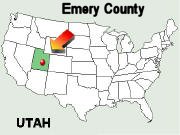 Origin:
S. parviflorus is the most widely distributed
species among the genus, it ranges from Arizona to Colorado, New Mexico
and Utah.
Habitat: distributed mostly along
the great river system above the 1000 m up to 2100m over sea level, live
on many type of soil, such Sandy, gravelly, or clay hills, mesas, and
washes, desert grasslands, red sand under sparse junipers trees, on
cracked clay plains etc. Origin:
S. parviflorus is the most widely distributed
species among the genus, it ranges from Arizona to Colorado, New Mexico
and Utah.
Habitat: distributed mostly along
the great river system above the 1000 m up to 2100m over sea level, live
on many type of soil, such Sandy, gravelly, or clay hills, mesas, and
washes, desert grasslands, red sand under sparse junipers trees, on
cracked clay plains etc.
|
|
Etymology:
The generic name
"Sclerocactus" derives from the Greek word “sclero”
meaning "hard ", "cruel”
referring
to the hard seed tegument or to the formidable spines,
and the word “cactus”
(an old genus name)
( The
genus name implies:
"hard cactus").
The
specific name "parviflorus"
derives
the Latin word
“parvus”
that means
"small"
and from
“florus”
the past participle
of
the Latin verb “floreo"
meaning "to
flower"
Named in the 30s by Clover and
Jotter,
S. parviflorus is
the
translation of the Latin, "small-flowered", a misnomer, whereas
this species has small flowers only in relationship to the
larger
bloomer of the genus:
S. polyancistrus
|
|
|
|
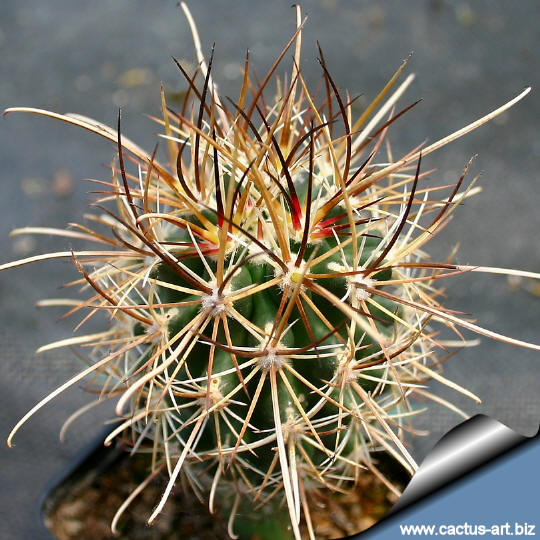
New spines
|
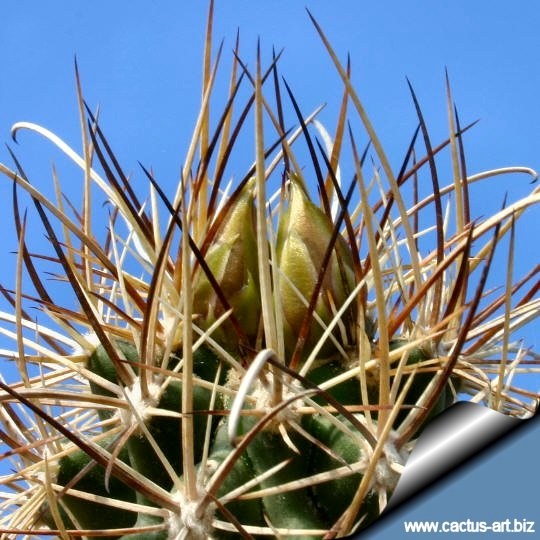
Buds
|
|
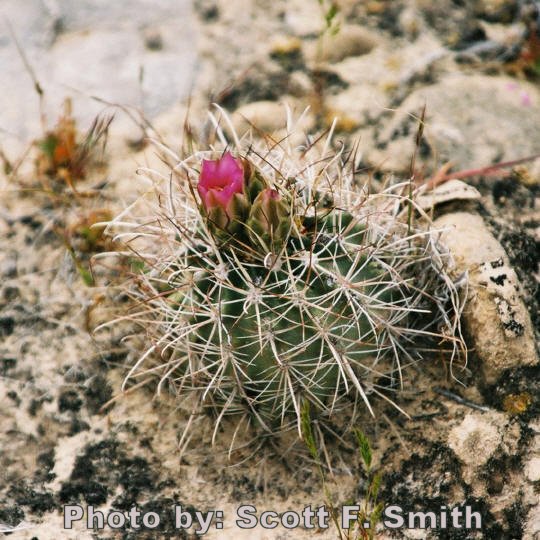
Pictures from the natural habitat of
S. parviflorus
Photos courteously provided by
Scott F. Smith.
|
|
|
|
Heterotypic synonyms:
-
Sclerocactus contortus
K.D.Heil 1979
Published in : Cact. & Succt. J. (US) 51:25-30,
1979.
-
Sclerocactus cloverae
K.D.Heil & J.M.Porter 1994
-
Pediocactus cloveriae
(K.D.Heil & J.M.Porter) Halda 1998
-
Sclerocactus cloverae subsp. brackii
K.D.Heil & J.M.Porter 1994
-
Pediocactus cloverae subsp. brackii
(K.D.Heil & J.M.Porter) Halda 1998
-
Sclerocactus whipplei var. aztecia
-
Sclerocactus whipplei var. heilii
-
Echinocactus parviflorus var. havasupaiensis (Clover) L. D.
Benson
-
Sclerocactus
parviflorus subsp. havasupaiensis (Clover) Hochstätter
-
Echinocereus parviflorus var. roseus (Clover) L. D. Benson
-
Sclerocactus
havasupaiensis
Clover var. roseus Clover
-
Sclerocactus
intermedius Peebles
Leafl. West. Bot.5:191, 1949
-
Sclerocactus parviflorus subsp.
intermedius (Peebles) Heil & Porter L. Benson
Published in: Haseltonia, 2. 20-46, 1994
-
Sclerocactus
parviflorus var. intermedius (Peebles) D. Woodruff & L. D.
Benson
Published in: Cact. & Succt, J. (US)
48 (3):133, 1976.
-
Sclerocactus
parviflorus subsp. terrae-canyonae (K. D. Heil) K. D. Heil &
J. M. Porter
-
Sclerocactus
terrae-canyonae K. D. Heil
-
Sclerocactus. whipplei var. intermedius
(Peebles) L. D. Benson
Published in: Cact. & Succt. J. (US)
48 (3):138-139, 1976.
-
Sclerocactus
whipplei var. roseus
(Clover) L. D. Benson
-
Sclerocactus parviflorus
Clover & Jotter var. blessingiae Earle
Published in: Saguaroland Bull. 34 (3): 29, 1980a
|
|